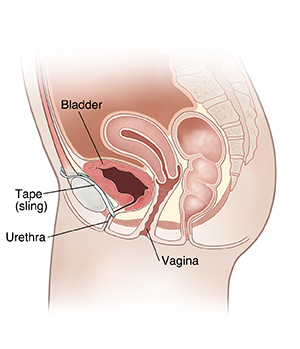Stress Urinary Incontinence: Having Midurethral Sling Surgery
To help treat stress urinary incontinence (SUI), your surgeon may do midurethral sling surgery. This is a minimally invasive procedure. A “sling” of tissue is placed under the urethra in a tension-free way. The sling (tape) is made from a mesh of artificial material. There are different types of sling procedures for treatment of SUI in women.
-
Retropubic midurethral sling or tension-free vaginal tape (TVT ) . The tape or mesh is pulled through the space behind the pubic bone. It is threaded through the abdominal wall above the pubic bone.
-
Transobturator midurethral sling or TVT obturator. The tape or mesh is put through the opening in the pelvis. It is threaded through the skin of the groin area.
-
Single incision midurethral sling or mini-sling. These are different from the other slings. They are shorter and need only a vaginal cut (incision).
Talk with your healthcare provider about the risks and benefits of each surgery. They will help you understand which is best for you.
How should I get ready for surgery?
The weeks before surgery
You will be asked to do some things at home to get ready for surgery. Below are guidelines to help you get ready. If you have any questions, call the healthcare staff.
-
Have all tests that your surgeon orders.
-
Tell your healthcare team about aspirin and other medicines, vitamins, or herbs you take. Ask if you should stop taking them before surgery.
-
Stop smoking. This is to help lower your risk of problems during and after surgery.
-
Fill prescriptions before the surgery.
The night before surgery
The day of surgery
-
Arrive at the hospital or surgery center a few hours before surgery as directed. Have someone drive you there who can also stay during the surgery. They will also need to drive you home.
-
At the facility, the healthcare staff will take your temperature, heart rate, and blood pressure. In some cases, you may have additional tests.
-
The healthcare staff will put in an IV (intravenous) line into your hand or arm. This line gives you fluids and medicines before, during, and after surgery.
-
The staff may put support stockings on your legs. These are to help prevent blood clots.
-
You will be asked to sign a form to give your consent for the surgery and anesthesia. Carefully read the information in the form. Ask questions if anything is unclear. Make sure all your questions are answered before you sign the forms.
About anesthesia
To keep you pain-free during surgery, you’ll have anesthesia. General anesthesia causes you to sleep during the surgery. Local anesthesia numbs the area of your body where the surgery is done. Before surgery, you’ll meet with the anesthesiologist or nurse anesthetist. They can tell you what kind of anesthesia you will get and answer questions you may have.
What happens during the procedure?
-
The surgeon will make 2 small cuts (incisions) in the lower part of your belly (abdomen), near the pubic hairline or in the inner upper part of your thighs. They will make another small incision in the front wall of the vagina.
-
The surgeon will work through the incisions to place the tape like a hammock under the urethra. The 2 ends of the tape emerge through the incisions.
-
If you’re given local anesthesia, your surgeon may tell you to cough so that the tension of the tape can be changed.
-
When the tension is changed, the ends of the tape are cut. They stay below the skin in the tissue of the abdominal wall. The healing process of the incisions holds the ends of the tape in place.
-
The surgeon will close the incisions in the abdomen and vagina with stitches (sutures).

What are the risks and possible complications?
The risks and possible complications include:
-
Infection
-
Bleeding
-
Problems from anesthesia
-
Blood clots
-
Damage to nerves, muscles, bladder, or nearby pelvic structures
-
Trouble urinating
-
Urinary urgency
-
Problems with sling (tape)
Online Medical Reviewer:
Marc Greenstein MD
Online Medical Reviewer:
Raymond Kent Turley BSN MSN RN
Online Medical Reviewer:
Rita Sather RN
Date Last Reviewed:
12/1/2022
© 2000-2025 The StayWell Company, LLC. All rights reserved. This information is not intended as a substitute for professional medical care. Always follow your healthcare professional's instructions.